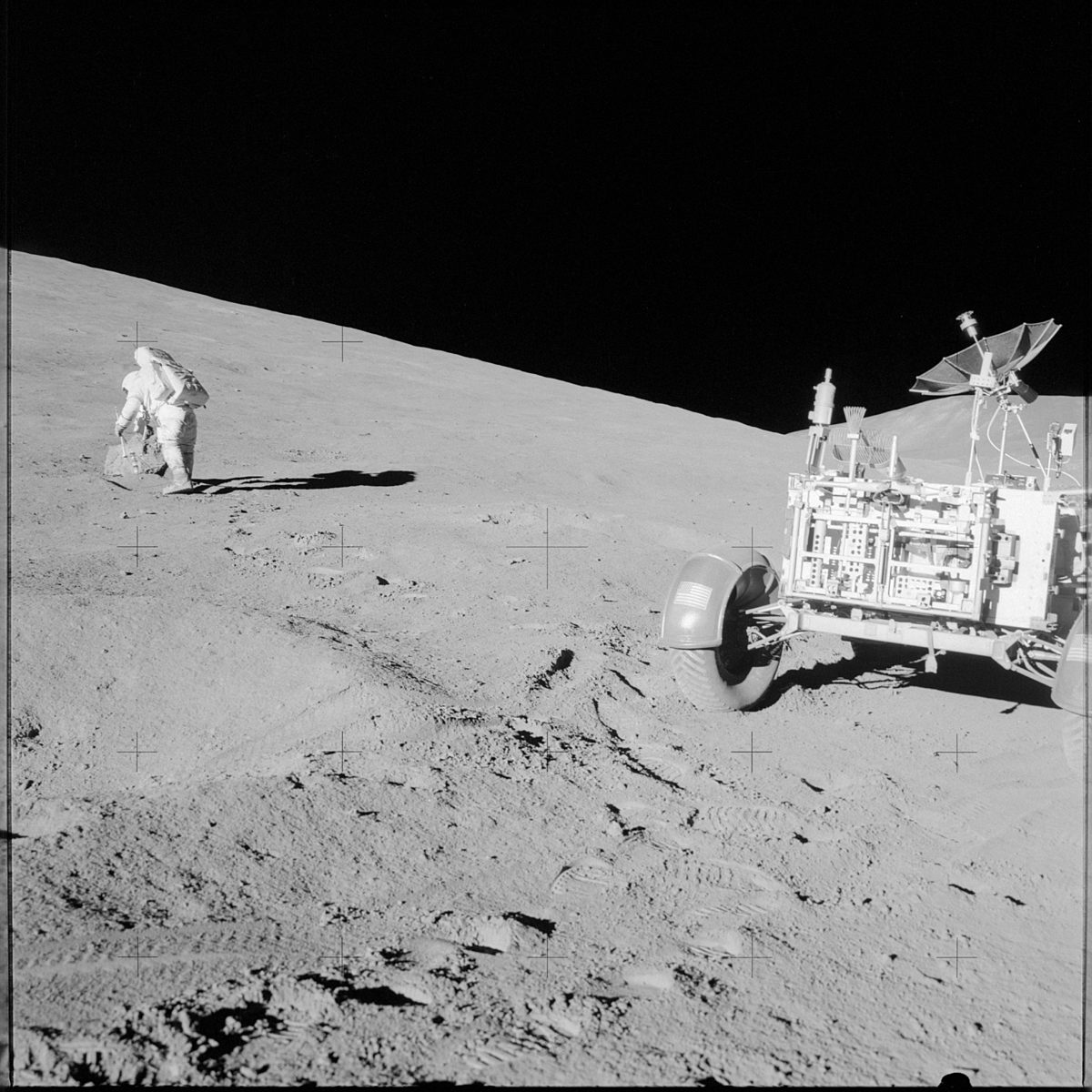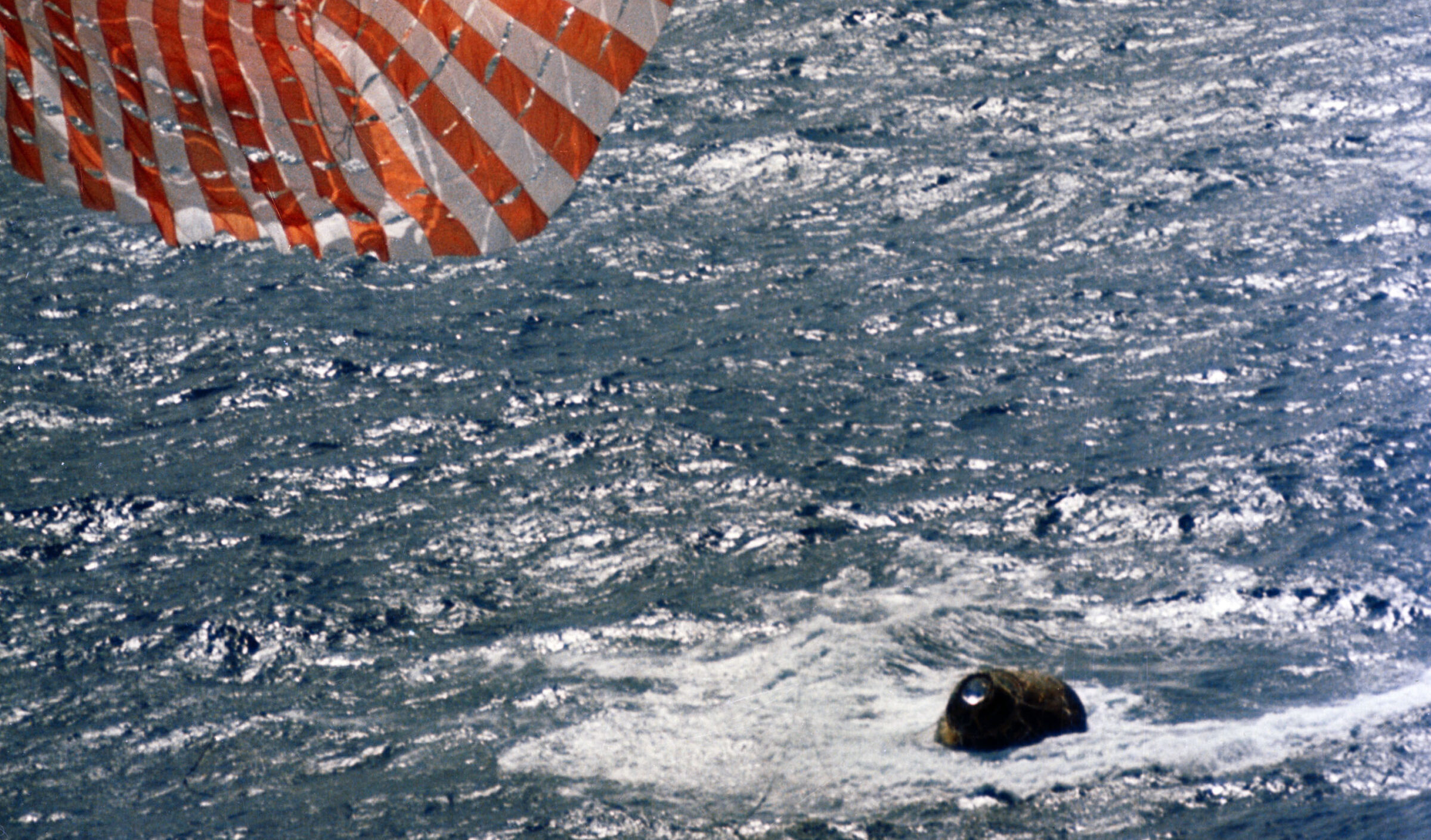Apollo 14 was the first mission to explore the lunar highlands, the bright, old, heavily cratered regions of the Moon that lie above its dark maria plains. It saw the first American in space become the 5th American to walk on the Moon. It was also a triumphant return to lunar exploration after the near-disaster of Apollo 13.
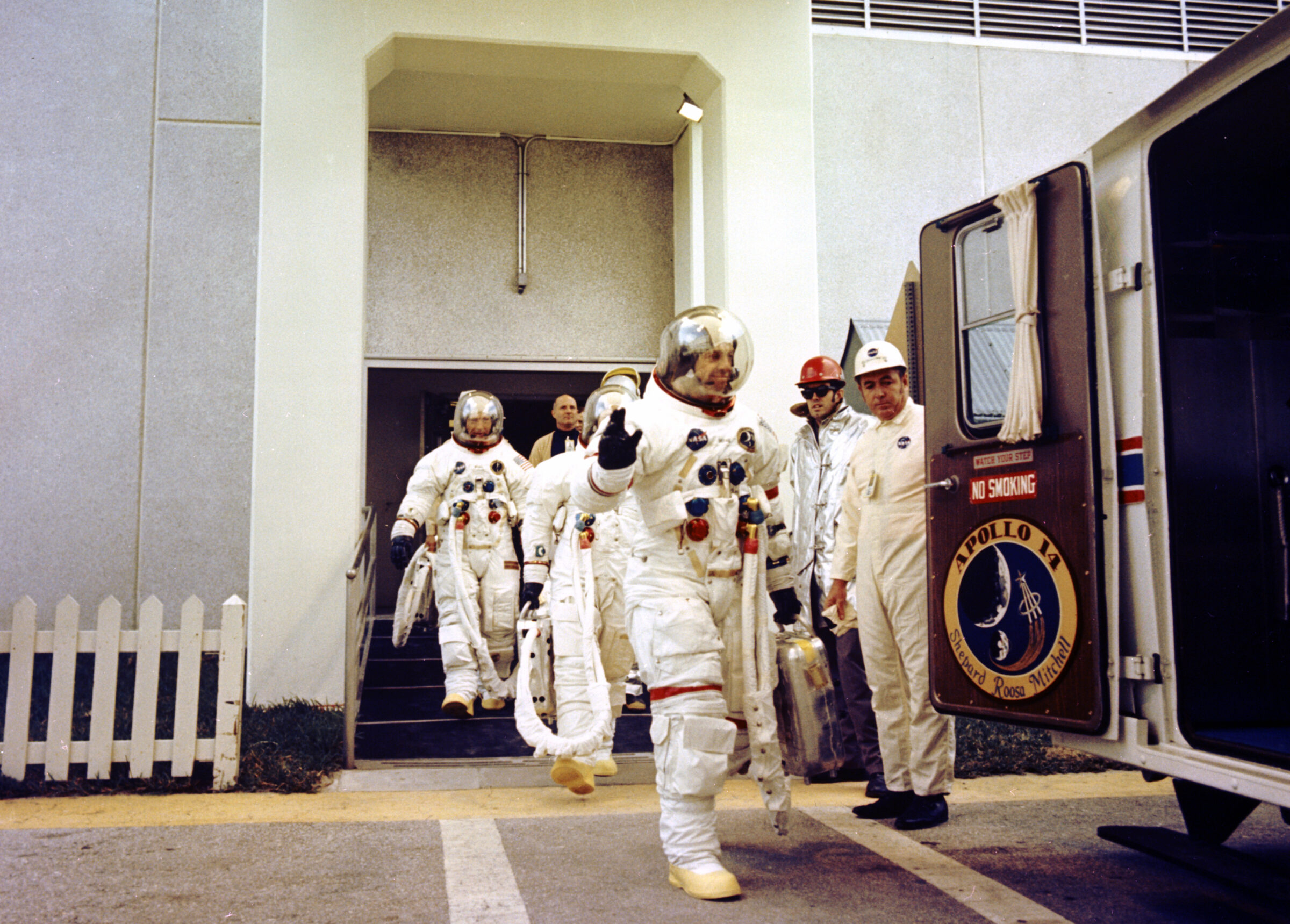
Commander Alan Shepard, Lunar Module Pilot Edgar Mitchell, and Command Module Pilot Stuart Roosa launched on 31 January 1971, after a 40-minute weather delay—the first such delay in the program. It was Shepard’s first launch since his historic Mercury 7 flight in May of 1961. He returned to flight in a space agency transformed: Shepard’s first flight was a 15-minute, suborbital arc launched by a modified Redstone missile. At that time, the U.S. trailed the Soviet Union both in rocket power and spacecraft capability. His second flight would be a 9-day mission to land on the Moon, launched atop the Saturn V, the most powerful rocket ever built. The U.S. was now the dominant space power, having already landed 4 astronauts on the lunar surface. The Soviet Union, meanwhile, had made no attempts to send astronauts beyond Earth orbit.
In the 10-month pause separating Apollos 13 and 14, NASA and its contractors made dozens of safety improvements to the command and service modules. The agency re-engineered oxygen tanks to reduce the possibility of sparks that could cause a fire, and installed additional, isolated backup systems of oxygen, batteries, and water.
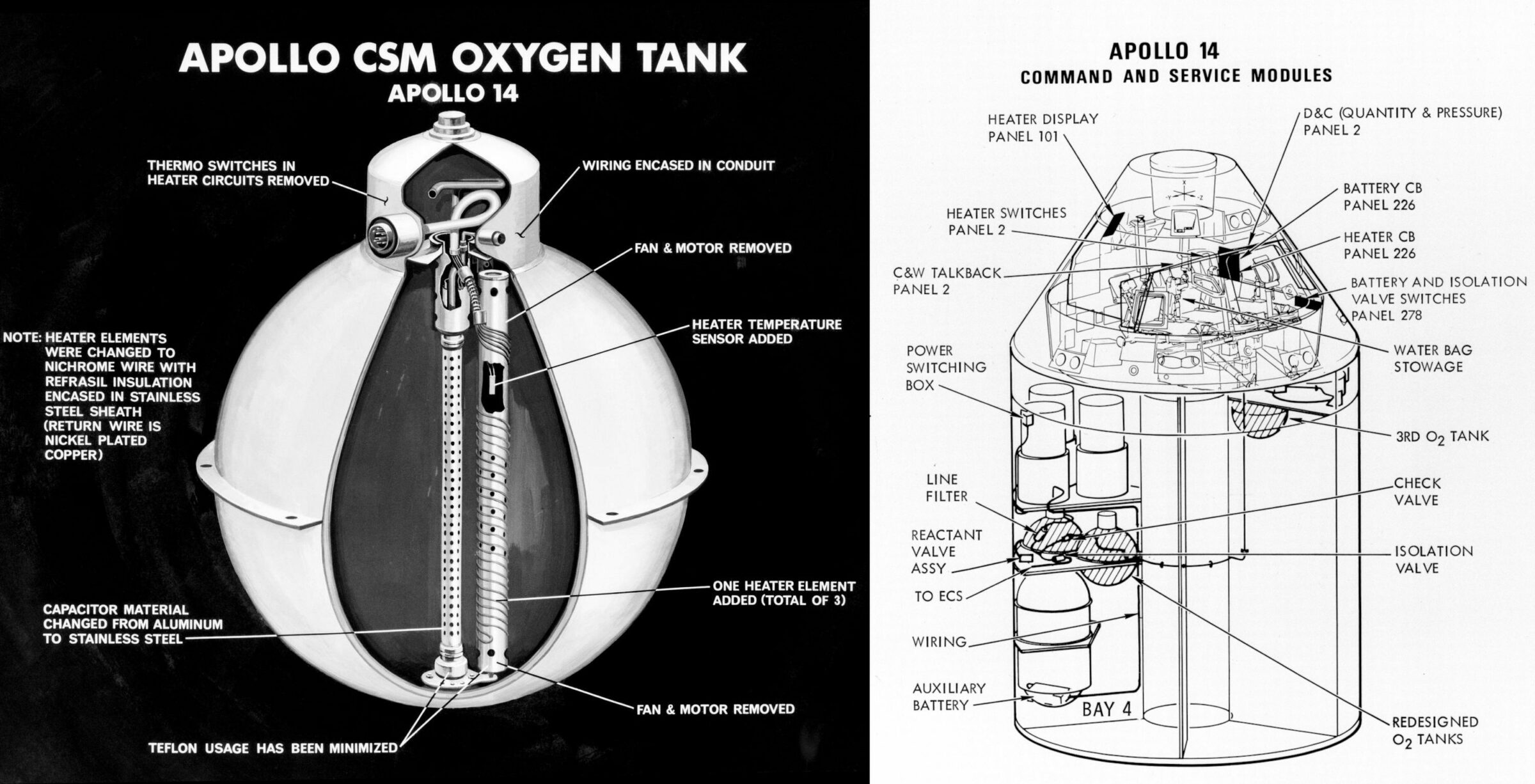
There was enormous pressure on NASA and the crew to deliver a successful mission. Political support was already dwindling prior to Apollo 13, when NASA received its smallest budget since 1962. As a consequence, the agency canceled 2 missions originally slated as Apollos 15 and 19. The near-disaster of Apollo 13 had spooked President Nixon, who briefly considered whether to continue Apollo at all. The space program could not endure 2 failures in a row. Apollo 14 had to succeed.
The mission began well. A flawless launch and subsequent upper-stage burns sent Apollo 14 en-route to the Moon as planned. But then came the first major problem: the crew was unable to dock with the Lunar Module (LM).
At launch, the Command and Service Module (CSM) was stacked at the very top of the Saturn V with the lunar module tucked beneath it, all attached to the 3rd stage of the rocket. This configuration was maintained during the initial Earth orbit through trans-lunar injection, in which the 3rd stage relit to send the crew out of Earth orbit and toward the Moon. Once completed, the Command Module separated from the 3rd stage, flipped around, docked with the Lunar Module, and pulled it free from the 3rd stage. Needless to say, if the crew could not successfully dock with the lunar module, there would be no landing.

Command module pilot Stu Roosa made 5 attempts to dock with the lunar module, but the latches on the docking assembly would not lock into place. The command module and lunar lander kept drifting apart. After nearly 2 hours of consulting with mission control, Roosa made a final attempt to dock, this time continuing to fire the service module’s thrusters to maintain contact while manually triggering the lock mechanism. It worked.
Post-mission analysis could find no manufacturing defects on the docking mechanism. The most likely explanation was that a small piece of debris prevented the automatic triggering of the latches. Future missions would launch with a protective cover over the command module’s docking equipment.
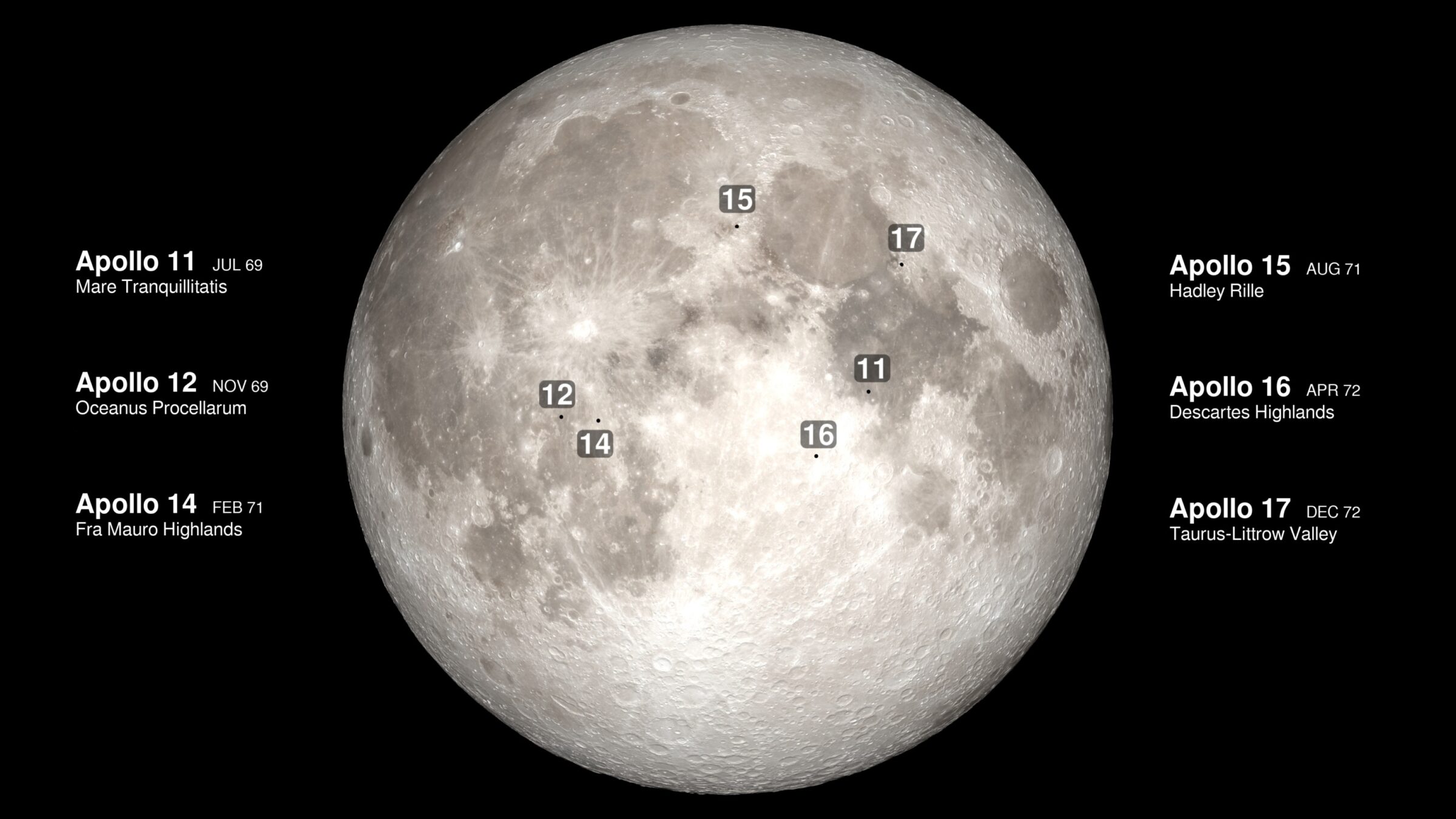
Apollos 11 and 12 landed on the relatively flat—and therefore relatively safe—mare regions of the Moon. These are the darker parts of the lunar surface composed of geologically young material created by volcanic activity. Apollo 14 targeted the bright highlands region of Fra Mauro, the same destination as Apollo 13. More of the Moon’s surface is highlands than maria, and to only return samples from maria would be to ignore a major aspect of lunar geology. Scientists also believed that the highlands regions were much older than the maria, which, while making them scientifically more interesting, meant they were more cratered and uneven. Safe landing areas were more difficult to find.
It turned out that landing would be the easy part. After separating from the command module but prior to their lunar descent phase, Al Shepard and Ed Mitchell found that the LM’s computer was errantly entering a mission abort mode. If the spacecraft had been in its descent phase, this would have caused the computer to fire the main engine and abort their one opportunity to land, a dangerous maneuver under any situation.
The astronauts found that tapping on the console near the switch would temporarily reset the abort reading, suggesting that a loose piece of solder or metal was shorting a circuit within the system. But this temporary solution was not enough to ensure a safe landing.
To solve this problem NASA summoned, Don Eyles, a 27-year-old computer engineer from MIT who had worked on the lunar landing program. In less than 2 hours, he wrote a system hot patch that the astronauts manually entered into the LM’s computer which told it to ignore the abort reading during descent. The fix worked.
Shepard landed the lunar module Antares nearer to his target landing site than any other Apollo mission. But due to the uneven terrain of the lunar highlands, Antares stood angled at nearly 7 degrees. This made it difficult for the astronauts to sleep comfortably, at times Shepard and Mitchell had to look out the window to make sure the LM wasn’t tipping over.
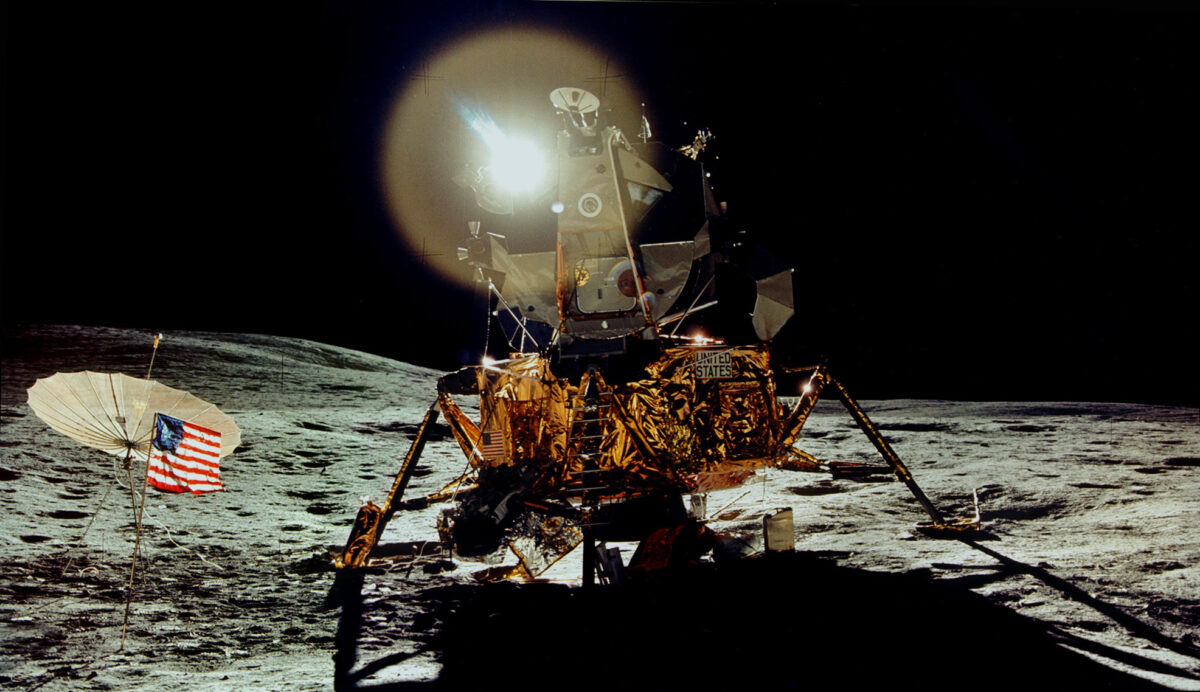
Shepard and Mitchell performed 2 spacewalks on the surface, deploying the instruments in the Apollo Lunar Surface Experiments Package (ALSEP) and collecting rock and regolith samples. They covered nearly 2.5 km (1.6 miles) in their second moonwalk, the furthest lunar excursion to date. The astronauts made first use of the Modular Equipment Transporter—a fancy name for what amounted to a space wheelbarrow—which was loaded with sampling equipment and other tools. It was the first wheeled vehicle on the surface of the Moon.
The undulating terrain made navigation difficult, and Shepard and Mitchell were unable to reach the rim of Cone crater, which would have provided them access to rock samples that could be used to date the age of the impact. After hours of searching, mission control called off the effort. Later, scientists determined that the astronauts had been within 15 meters (50 feet) of the crater rim.
The Lunar Rover Wasn’t the Only Drive on the Moon
Alan Shepard, an avid golfer, snuck 2 golf balls and a modified club onboard Apollo 14. Using his lunar sampling tool as a handle, he constructed a makeshift golf club and attempted 4 one-handed swings (the spacesuit limited his mobility) until he made what is probably the longest drive in golf history—aided, of course, by the 1/6 gravity and airless environment of the Moon.

After slightly more than 33 hours on the surface, Shepard and Mitchell departed carrying with them nearly 46 kilograms (96 pounds) of surface samples. The remainder of the mission was uneventful, and the crew splashed down in the Pacific Ocean on 9 February 1971, marking a successful return to lunar exploration for NASA.
Apollo 14 Timeline
| Event | Time (UTC) | Date |
|---|---|---|
| Liftoff | 21:03:02 | 31 Jan 1971 |
| Earth orbit insertion | 21:14:52 | 31 Jan 1971 |
| Trans-lunar injection | 23:37:35 | 31 Jan 1971 |
| 1st docking attempt | 00:16:55 | 01 Feb 1971 |
| 2nd docking attempt | 00:17:45 | 01 Feb 1971 |
| 3rd docking attempt | 00:19:45 | 01 Feb 1971 |
| 4th docking attempt | 00:26:43 | 01 Feb 1971 |
| 5th docking attempt | 01:35:31 | 01 Feb 1971 |
| Lunar Orbit Injection Burn | 06:59:42 | 04 Feb 1971 |
| CSM/LM undocking | 04:50:46 | 05 Feb 1971 |
| LM begin powered descent | 09:05:28 | 05 Feb 1971 |
| LM lunar landing | 09:18:11 | 05 Feb 1971 |
| 1st EVA started | 14:42:13 | 05 Feb 1971 |
| Shepard on lunar surface | 14:54 | 05 Feb 1971 |
| 1st EVA ended | 19:30:03 | 05 Feb 1971 |
| 2nd EVA started | 08:11:15 | 06 Feb 1971 |
| 2nd EVA ended | 12:45:56 | 06 Feb 1971 |
| LM lunar liftoff | 18:48:42 | 06 Feb 1971 |
| CSM/LM docked | 20:35:52 | 06 Feb 1971 |
| Transearth injection ignition | 01:39:04 | 07 Feb 1971 |
| Entry | 20:50:47 | 09 Feb 1971 |
| Splashdown | 21:05:00 | 09 Feb 1971 |
Apollo 14 Cost
NASA estimated the following marginal costs for Apollo 14. Full costs of the Apollo program can be found on the "How Much Did the Apollo Program Cost?" page.
| original $ | inflation adjusted $ | |
|---|---|---|
| Command & Service Module | $55 million | $443 million |
| Lunar Module | $40 million | $323 million |
| Saturn V Launch Vehicle | $185 million | $1.5 billion |
| Apollo Lunar Surface Experiments Package (ALSEP) | $25 million | $201 million |
| Operations | $95 million | $766 million |
| Total | $375 million | $3.2 billion |
Resources
Project Apollo
Starting with Apollo 7 in 1968 and culminating with Apollo 17 in 1972, NASA launched 33 astronauts on 11 Apollo missions. Twelve humans walked on the Moon.


 Explore Worlds
Explore Worlds Find Life
Find Life Defend Earth
Defend Earth


